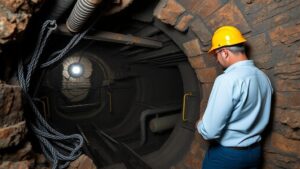The Role of Windlass Systems in Medieval and Early Modern Shaft Mining
The Role of Windlass Systems in Medieval and Early Modern Shaft Mining
Windlass systems played a crucial role in the evolution of shaft mining during the medieval and early modern periods. These mechanical devices enabled miners to hoist materials from significant depths, facilitating the extraction of valuable resources such as minerals and ores. This article delves into the operation, significance, and technological advancements of windlass systems in mining practices of the era.
Understanding Windlass Systems
A windlass is a simple mechanical device consisting of a rotating drum around which a rope or chain is wound. By utilizing manual or animal power, windlasses were primarily used for raising and lowering materials through deep shafts. The basic principle of operation relies on applying torque to the drum, which in turn pulls the attached haulage system and the load connected to it.
Windlass systems can be divided into two main categories: the hand-powered windlass and the animal-powered windlass. The hand-powered variant required miners to turn a crank, while the animal-powered version utilized animals like horses or mules to drive the windlass, significantly increasing efficiency.
Historical Context and Development
In medieval Europe, the demand for metal ores, particularly iron and later copper and silver, spurred innovations in mining technology. Early windlass systems appeared around the 12th century and became more prevalent by the 15th century. These mechanical advancements directly corresponded with increased mining activity necessitated by growing urban centers and the burgeoning demand for metal goods.
For example, the mining industry in England saw significant development with the introduction of windlass systems, which allowed for deeper and more efficient mining operations. The Cornish tin industry, known for its depth and complexity, heavily relied on windlass technology during the 16th century.
Technological Specifications and Performance
Windlass systems were engineered to operate effectively under the physical limitations of the time. Typically, the drum would vary in diameter, leading to a mechanical advantage through leverage. The materials used in construction ranged from wood to metal, reflecting the regions available resources.
Efficiency was often measured in terms of the weight of materials hoisted per unit of time. For example, a well-maintained windlass could lift approximately 200-300 pounds for a depth of over 100 feet, depending on the size of the pulley and manpower utilized. This enabled miners to remove debris and valuable minerals, enhancing overall productivity.
Advantages of Windlass Systems
- Cost-Effective: Windlass systems were affordable to construct and maintain, facilitating widespread adoption among miners.
- Labor-Saving: By using mechanical advantage, windlasses reduced the physical burden on miners, allowing them to transport larger loads with less effort.
- Adaptability: The design could be modified to suit various mining environments and depths, making it suitable for diverse geological conditions.
Case Studies and Applications
The use of windlass systems can be exemplified in the silver mining operations of the 16th century in Germany. The miners employed a two-man-operated windlass to extract silver ore from the depths of the Harz Mountains. This application not only illustrates the windlasss practicality but also demonstrates its significant contribution to local economies.
Another notable example is the workings in the German-speaking regions of Saxony, where miners increasingly employed the windlass alongside deeper shaft construction. This integration of technology marked a turning point in the efficiency of mining operations during this period.
Challenges and Limitations
Despite their advantages, windlass systems also faced challenges. For example, the manual or animal power required for operation limited the speed at which materials could be hoisted. Plus, as mining depths increased and logistical demands grew, windless systems sometimes proved insufficient, leading to the exploration of more advanced technologies such as steam engines in the later phases of mining development.
Conclusion and Actionable Takeaways
The windlass system significantly impacted shaft mining in the medieval and early modern periods by improving the efficiency and feasibility of material extraction. It exemplifies the ingenuity of mining engineers who sought to adapt technologies to meet the demands of increasingly ambitious mining operations. Understanding these systems provides insights into the evolution of mining technology and its socio-economic implications during this historical period.
For modern mining professionals and historians, examining the windlass system not only sheds light on past technological practices but also informs contemporary discussions about efficiency, resource extraction, and engineering innovation.


